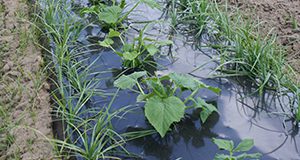Vegetable growers are keen on cost-cutting measures to increase profitability. Containerized vegetable production can be done in a shade-house or garden, and it often requires commercial potting media. Although expensive, potting media are lightweight and provide high water- and nutrient-holding capacities, and thus they are widely used by growers. Growers often discard or compost the potting media after a single season due to issues such as diseases, pests, and weeds. However, old potting media could be reused for containerized production if appropriately sterilized and amended with fertilizer salts. The current study was conducted to determine the feasibility of using sterilized recycled potting medium amended with fertilizer salts for containerized production of squash. This new 4-page publication of the UF/IFAS Horticultural Sciences Department was written by Marie Dorval, Riphine Mainviel, Vincent Michael, Yuqing Fu, Bala Rathinasabapathi, and Geoffrey Meru.
https://edis.ifas.ufl.edu/hs1404
Tag: Squash
Summer Squash Production in Miami-Dade County, Florida

Summer squash is an important vegetable crop in Miami-Dade County. It is grown annually on about 6,000 acres and sold nationwide during the winter in the fresh market. This 16-page fact sheet describes the varieties of summer squash, land preparation and transplanting, what fertilizer to use, irrigation and freeze protection, disease management, insect management, weed management, harvest, and crop rotation. Written by D. Seal, S. Zhang, M. Ozores-Hampton, P. Dittmar, Y. Li, W. Klassen, Q. Wang, and T. Olczyk and published by the Horticultural Sciences Department.
http://edis.ifas.ufl.edu/tr012
A Summary of N,P, and K Research with Squash in Florida (SL343/CV227)
Fertilizer is a major part of the crop production expenses for vining and bush squash, but is critical for successful crop yields and high fruit quality in Florida. This 12-page fact sheet summarize squash fertilization research results from studies conducted in Florida, which have been used to develop the current University of Florida nitrogen (N) recommendations for squash fertilization. Written by George Hochmuth and Ed Hanlon and published by the UF Department of Soil and Water Science, March 2011.
http://edis.ifas.ufl.edu/cv227
HS1149/HS398 Home Vegetable Garden Techniques: Hand Pollination of Squash and Corn in Small Gardens
HS-1149, a 4-page illustrated fact sheet by Ed Thralls and Danielle Treadwell, addresses techniques for hand pollination of squash and corn to produce bountiful harvests in home gardens. Includes references. Published by the UF Department of Horticultural Sciences, December 2008.
http://edis.ifas.ufl.edu/HS398
